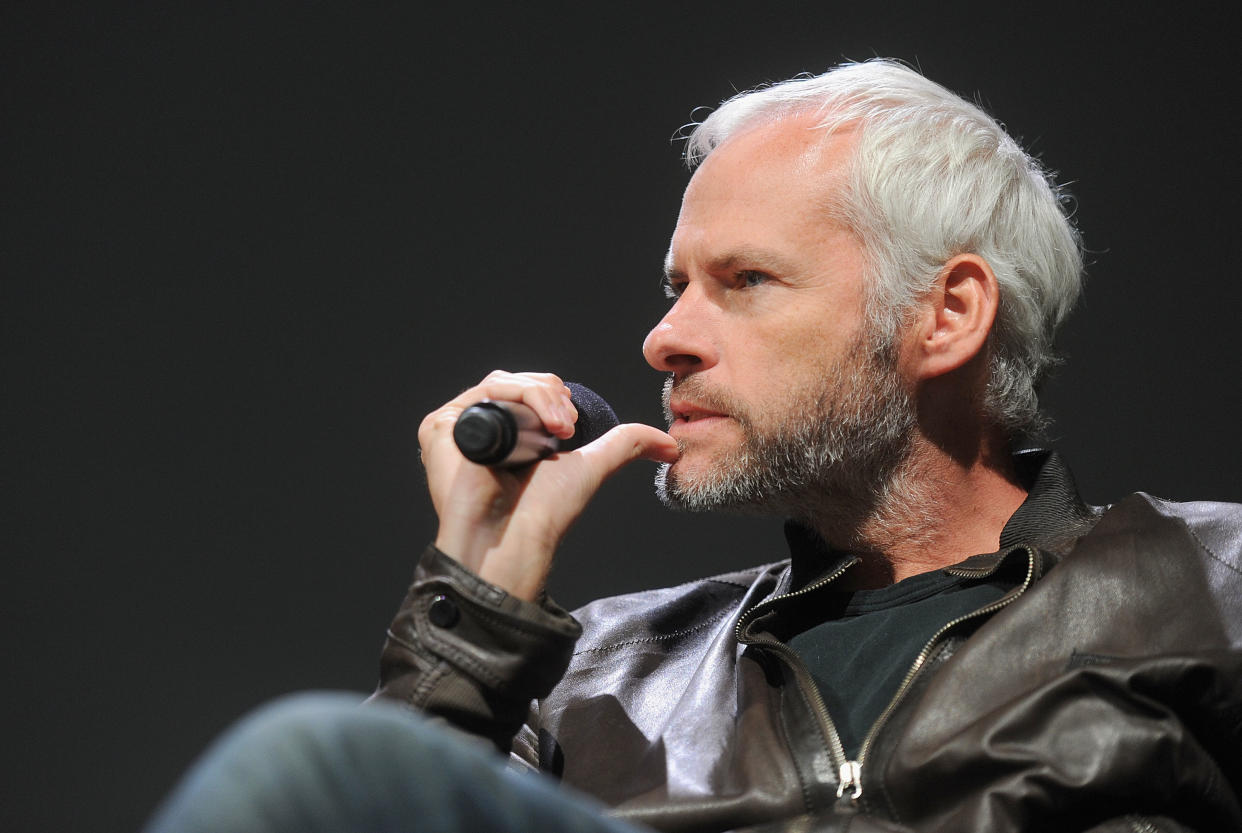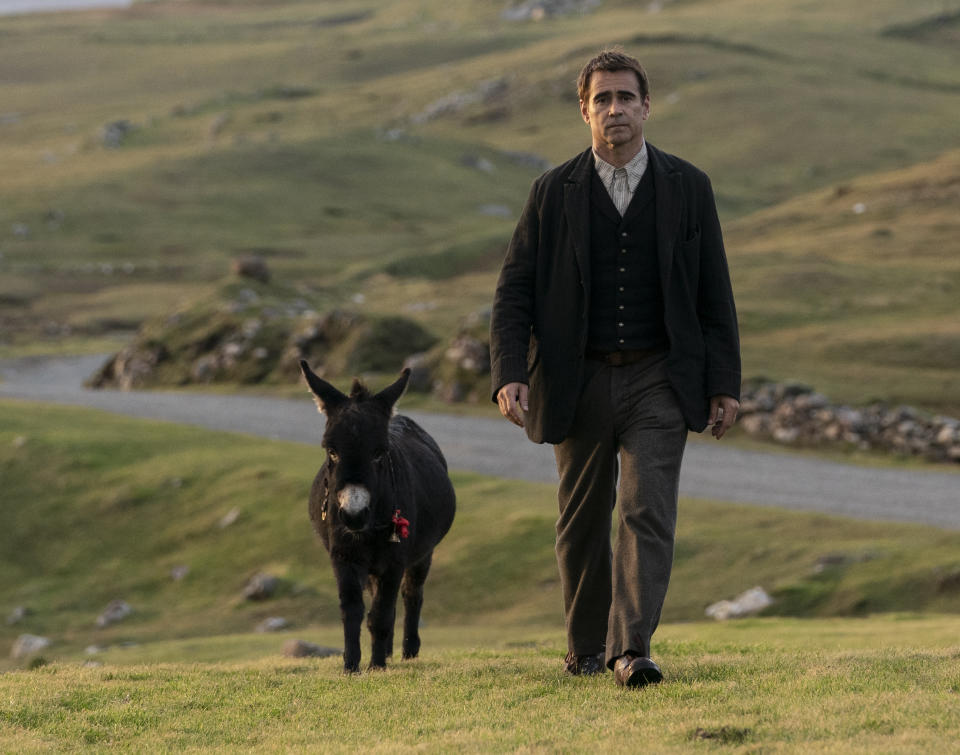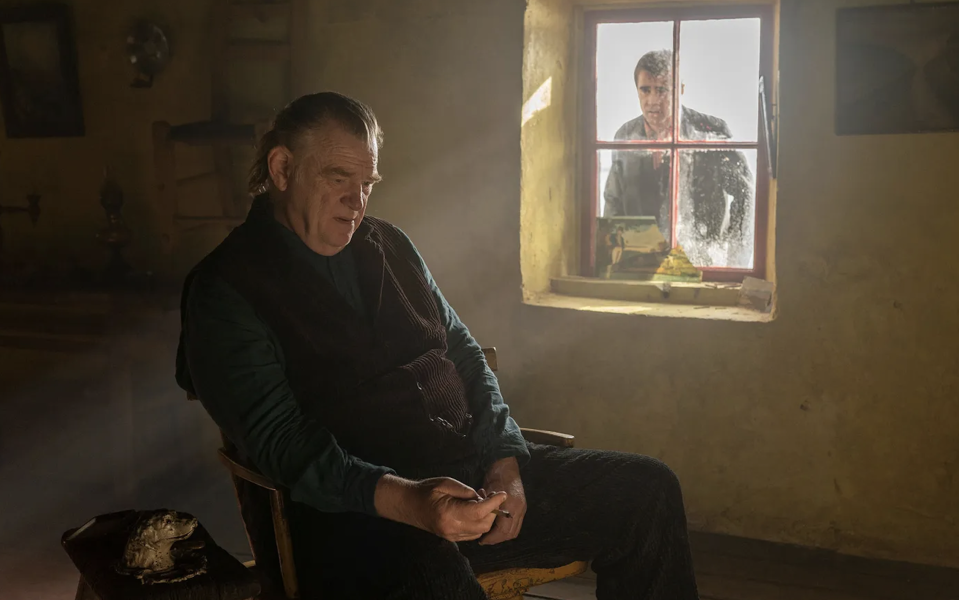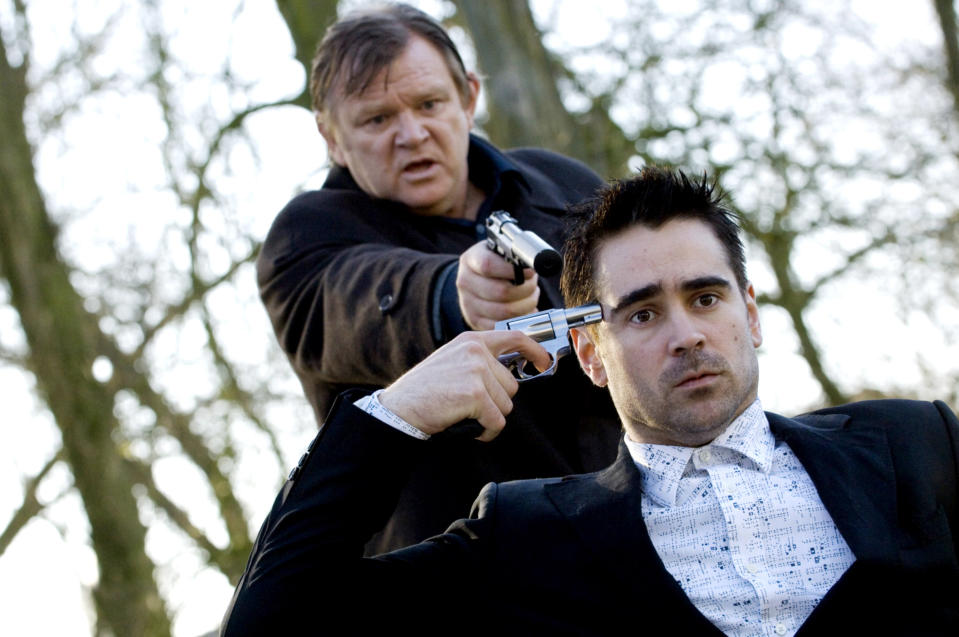‘The Banshees of Inisherin’ Confronts the One Subject Martin McDonagh Doesn’t Want to Discuss

- Oops!Something went wrong.Please try again later.
- Oops!Something went wrong.Please try again later.
- Oops!Something went wrong.Please try again later.
- Oops!Something went wrong.Please try again later.
- Oops!Something went wrong.Please try again later.
Martin McDonagh is the rare storyteller celebrated on the stage and screen alike, a fusion he loves to discuss.
“I always preferred movies to plays,” he told me in a recent conversation I moderated with the writer-director at the Hamptons Film Festival, shortly before a screening of “The Banshees of Inisherin,” his fourth feature. “The plays I saw as a kid were very dull.” He added under his breath, with acute comic timing, “I grew up in England.”
More from IndieWire
'Bones and All': How Director David Gordon Green Landed Unexpected Role in Cannibal Romance
Want Colin Farrell's 'Banshees of Inisherin' Sweaters? You'll Need to Find an Octogenarian Knitter
The crowd roared. Yet McDonagh’s roots are more complicated than that, and that complexity sits at the root of his work, never with more prominence than it does in “Banshees.” His first movie set in Ireland in almost 20 years relates back to his youth, and wrestles with deep questions about national identity, whether he wants to talk about it or not.
As the child of Irish parents who took their son back to their homeland, McDonagh developed a layered relationship to his heritage, one that he rarely addresses in the open. “I’ve never called myself British,” he told IndieWire in an interview after the public conversation wrapped. “London-Irish is an easy, non-patriotic version of what I think I mean, even though it makes no sense.”
He won’t go much further than that. “Honestly, and this isn’t a ‘no comment’ thing, but I’m just too bored talking about it these days,” he said. Nevertheless, McDonagh is working within an Irish register that begs for a closer look, because it’s part of the reason why it all works so well.
McDonagh’s last movie set in the country was the 2004 short “Six Shooter,” which won an Academy Award. “Banshees” marks quite the homecoming, as it stars the two most famous Irish actors working today — Colin Farrell and Brendan Gleeson, as old pals who have a falling out — and takes place in a remote Irish island during the Irish Civil War of 1922. McDonagh’s first acclaimed trilogy of plays, starting with “The Beauty Queen of Leenane” in 1996, took place in Galway and his second trilogy — which was unfinished — took place on the Aran Islands; “Banshees” was shot there. All in all, it certainly seems like McDonagh wants to grapple with the history and personality of the country after setting it aside for almost two decades.

Searchlight Pictures
But he doesn’t put it that way. “I don’t feel like I’ve ever really left Ireland,” he said. “I’m always going back there to stage the old plays.” His 2008 feature debut “In Bruges” also starred Farrell and Gleeson, but took place in Belgium. “But I think it’s an Irish film because they’re Irish and I’m half-Irish,” McDonagh said. “So it isn’t really a return to anything. I guess because I’m sort of anti-nationalistic, it’s just a weird thing to have to define.”
McDonagh has always grappled with people who feel at once out of place and exactly where they belong. At the age of 52, he has crafted angry, troubled souls through a tragicomic lens for the stage and screen alike for a quarter of a century. His plays have been staged from Mexico to Japan, while his movies have garnered him critical acclaim and awards recognition. “He tells universal stories of humanity,” said Graham Broadbent, who has produced all four of McDonagh’s features, “with comedy and darkness in a way that no one else can. That unique McDonagh quality works around the world.”
At the same time, his depiction of Ireland risks backlash. “There’s a certain degree of unease in Ireland about McDonagh’s post-modern, heightened versions of Irishness,” the Irish film critic Donald Clarke told me, speaking over Zoom a few hours before the Dublin premiere of the movie. “The films and plays do well here. But there is a tension in Ireland about his treatment of the country.”
The subject of Irish cinema can be a sensitive one within the country’s borders. McDonagh’s brother, John Michael McDonagh, is also a filmmaker and dealt with this firsthand, facing immediate pushback after he told the Associated Press that his own dark comedy “Calvary” (which also starred Gleeson) wasn’t Irish. “I’m not a big fan of Irish movies,” he said. “I don’t find them that intelligent. I’m trying to get away from the description of the movie as an Irish film.” He was later lambasted by the Irish Film Board, which invested in the production.
With that history, it’s no wonder that Martin McDonagh would prefer to dance around any questions pertaining to the national identity of his work. But resistance to the caricatures in McDonagh’s plays and films have extended beyond Irish borders.

Jonathan Hession/Courtesy of Searchlight Pictures
His characters are exaggerated to an almost allegorical degree in order to comment on the society around them, which has led some American audiences to see his view of the country as naive. Despite the acclaim for “Three Billboards,” the plight of Frances McDormand’s grief-stricken mother to seek justice for the rape and murder of her daughter was loaded with Southern archetypes. McDonagh was often lambasted on the promotional tour of that movie for depicting a racist police officer (Sam Rockwell) with some measure of empathy.
Yet losers, outcasts, and even morally decrepit people have been the focus in all of McDonagh’s work. The shock of the material is that McDonagh makes them all seem familiar. “You do have to see each character as the hero of the piece,” he said during the Hamptons conversation. “They’re all the lead actors in their own story.”
In “Banshees,” the question of representation has less to do with whether McDonagh likes his characters so much as how he frames them through an archetypal lens. “Banshees” burrows into the stereotype of Irish people at pubs, guzzling pints to the tune of ebullient folk music, and molds it into an emotionally resonant character study. “The starting point was to capture the sadness of a breakup, be it a love breakup or a friendship one,” McDonagh said. “Being on both sides of that is an equally horrible position. To treat the sadness of both sides as truthfully as possible was the main thing I wanted to get right with this.”
Violence tends to trickle into McDonagh’s work as a constant reminder that nobody can ever live at ease. That’s an especially striking observation in a movie set in rural Ireland, where even a major war barely impacts the hum of day-to-day existence. At a certain point, Colm (Gleeson) tries to tell Pádraic (Farrell) to get off his back and makes a shocking threat: If Pádraic doesn’t leave him alone, then Colm, a talented violinist, will start lopping off his own fingers. “I thought it was interesting that an artist would threaten the thing that allows him to make art,” McDonagh said. “Does that thing make him the artist?”
On the subject of Colm, McDonagh is willing to acknowledge the personal dimension of the work. Gleeson’s character doesn’t hold a grudge against Pádraic; instead, the fiddler simply worries that he’s wasting too much of his finite life hanging out with his pal rather than focusing on more meaningful pursuits. The root of who we are is a constant push-pull between where we come from and what we aspire to be. That’s the Colm conundrum — and a stand-in for McDonagh’s own complicated state.

Searchlight
“I’m in that quandary now,” he said. “You’ve got this much time left. What do you choose to devote it to?” That feeling became especially acute to him over the last two years. His 2015 play, “Hangman,” was originally supposed to reach Broadway in early 2020 until the pandemic pushed it off the calendar. “There were tears. It was horrible,” he said. “There was worry in the theater community — is it all going to be gone?” (The play opened on Broadway earlier this year and scored five Tony nominations.)
With its largely outdoor setting and small-scale cast, “Banshees” was readymade for COVID-era regulations. Three weeks of production for “The Banshees of Inisherin” took place in part on the island of Inishmore, the largest of the Aran Islands, and it allowed the crew to avoid the worst of the pandemic. “I used to think it was touristy, but there’s something quite magical about it,” McDonagh said. “I did want to show Ireland in its beauty. I don’t really feel like it’s been captured enough in the movies. A lot of Irish films are very low-budget and the cinema of them can be lost in a way. To capture the beauty of Western Ireland was in all of our minds.”
McDonagh even used the sweeping landscape to convey the dueling personalities of his two main characters: They shot Colm’s home on Achill Island, where the rugged terrain matched his mood; the less sophisticated Pádraic had his scenes shot in Inishmore, which is comparatively flatter. Although Farrell gives a heartfelt performance as Pádraic, who wants little more than the friendship and routine of island life, Gleeson soars to even greater heights as a man both deranged and relatable at once.
The strength of the role helped him score a hosting gig on “Saturday Night Live” this month, in which he leaned hard on his Irish heritage with ample affection. (McDonagh helped write the opening monologue.) Clarke told me that there were concerns, when Gleeson was announced as host, that he would fall into the same trappings as Saoirse Ronan when she hosted the show in 2017. One sketch in which the “Lady Bird” star played an Aer Lingus flight attendant was criticized for leaning hard on stereotypes.
It was the same kind of broad material that McDonagh has been accused of applying in his own work. “Someone was like, ‘I hope he doesn’t get involved with those clichéd Irish sketches like Saoirse Ronan did,'” Clarke said. “And someone else said, ‘Oh, like playing the fiddle at the table and drinking a pint of Guinness?’ And there is some of that going on in this film. But that element is generally worked through quite well. It’s a subtext, a rumbling in the background rather than any kind of gross characterization.”
There’s also a critical turning point in the movie where it becomes more focused on the decision by Pádraic’s sister, played by Kerry Condon, to escape the monotony of island life. “She started out as the sisterly voice of reason,” McDonagh said. “If you go down that road with her intelligence, her empathy, and her anger, by the end you feel that she’s got to either commit suicide or leave the place.”
There’s a degree of self-awareness in McDonagh’s writing that gives him additional leeway with his portrait of the country and its islands. In “The Cripple of Inishmaan,” the second of play in his Aran Island trilogy, characters contend with the arrival of a Hollywood crew who come to their remote community to document their lives. The story is a literal embodiment of what it means when genuine culture becomes content from an outsider’s point of view.
But it was an outsider’s view that inspired McDonagh in the first place. He cites American films of the 1970s like “Mean Streets” and “Badlands” as his earliest inspiration. The grittiness of early Scorsese matched with the poetry of Malick gave McDongh the precise blend he needed to uncover his own unique aesthetic. “I wanted to take that influence onto the stage,” he said. “It was then a natural progression to make films.”
Those films have always been a direct extension of McDonagh’s stage work, in part because he resists any feedback from the studios. When he made his first feature, “In Bruges,” he clashed with executives at Focus Features on a regular basis. “They were just questioning every decision, wanting to see every storyboard, even questioning the lighting of the scene, and the tone of scenes,” he said. “Especially as a first-time filmmaker you don’t want that shit on your shoulder.”
He clarified that nothing in “In Bruges” differed from the way he intended it. “We didn’t lose any of the battles,” he said. “I just felt it became an unnecessary sort of daily warfare to get my own way. So it’s exactly the film I wanted to make, but it’s the reason I haven’t worked with them since. I did swear them off.”

©Focus Features/Courtesy Everett Collection
From that point forward, he has insisted on final cut in his contract — and got even it on “Banshees,” a movie produced by the Disney-owned Searchlight. The movies have all been made for $15 million range, a manageable scale by studio standards that lets McDonagh get away with creative freedom. “That is the reason why the films are singular,” he said. “It is all me. It hasn’t been watered down, for good or bad.” For Broadbent, this is a natural outcome. “Martin has earned the right to make the films he wants in the way he wants,” he said. “He has an understanding of the risks and compromises of making films. What people are buying into is a Martin McDonagh film.”
In recent years, McDonagh has seen filmmaking as a greater asset than his plays, even if the theater established him. “During COVID, I wondered what I was leaving behind that will last, and that’s the films,” he said. “Plays don’t do that. I would like to be able to show you how good ‘The Lieutenant of Inishmore’ was 20 years ago and I can’t. That is an issue when you think about legacy.”
Still, he continues to tinker with his theater work, with plans to restage his seminal dystopian play “The Pillowman” next year with a gender-swapped lead performance: The role of the main character, played in the memorable 2005 Broadway production by Billy Crudup, will now go to a woman. (A different production was originally set to hit West End in 2020 with Aaron Taylor-Johnson in that role until the pandemic came along.) “I often get asked if you can change the sex of the actors in my plays,” McDonagh said. “I think it’s interesting to take that up a bit.”
McDonagh insists his plays shouldn’t be movies. “If anything is set in one room, it’s either going to be a play or a bad film,” he said at the Hamptons conversation, then wondered aloud if there have been any good movies set in a single room. When someone from the audience shouted out “Frost/Nixon,” McDonagh flashed a naughty grin. “That was a bad play and a bad film,” he said. “Sorry!”
McDonagh has the spunky energy of an aging punk rocker, an iconoclast in the throes of a midlife crisis, which also helps explain the wistful mischief at the center of “Banshees.” He brings that same blend to a wide array of topics, including the recent death of the Queen. “Even me, as someone who hates the whole idea of the royal family, she’s someone who was there since our entire childhoods and isn’t there anymore,” he said. “I’m obviously not a monarchist at all, but I don’t think there’s an Irish person who is.”
He didn’t double back to acknowledge that he’d just described himself as Irish. If McDonagh has issues with the way he’s perceived, they don’t involve his origin story. He has built his own world and, no matter its hardships, wants to see his characters succeed. “I always take umbrage at reviews of some of my plays where they just see them as nihilistic,” he said. “I always feel like they miss what could be just two lines of hope in a dark story. I think that’s enough — if you’re paying attention.”
Searchlight Pictures releases “The Banshees of Inisherin” in limited release on Friday, October 21 with a national expansion to follow.
Best of IndieWire
24 Famously Queer and Homoerotic Horror Movies, from 'Psycho' to 'Hellraiser'
All the Details on 'Hunger Games' Prequel 'The Ballad of Songbirds and Snakes'
Sign up for Indiewire's Newsletter. For the latest news, follow us on Facebook, Twitter, and Instagram.

